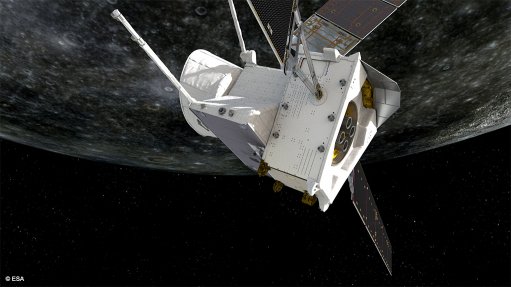
An artist’s impression of BepiColombo during its first Mercury flyby
Photo by: European Space Agency
The European Space Agency (ESA) has highlighted that its joint space mission with the Japan Aerospace Exploration Agency (Jaxa), BepiColombo, will make its first flyby of the planet Mercury in the early hours of Saturday morning, South African (and Central European) time. Saturday (October 2) will also be the 101st anniversary of the birth of the Italian scientist after whom the mission is named, Giuseppe ‘Bepi’ Colombo (1920-1984).
The BepiColombo mission is focused on studying Mercury, and this flyby will be the first of six of the planet closest to our Sun. These flybys will both adjust the spacecraft’s trajectory and help decelerate it, so that it can enter the orbit of Mercury with the minimum expenditure of fuel. BepiColombo, which is equipped with solar electric propulsion, is programmed to enter planetary orbit in 2025.
This process is complicated by the fact that BepiColombo is not a single spacecraft but actually a ‘stack’ of three spacecraft. These are the Mercury Planetary Orbiter (led by ESA), the Mercury Magnetospheric Orbiter (led by Jaxa) and the Mercury Transfer Module, which is the actual interplanetary spacecraft carrying the two orbiters to Mercury. Complicating matters even more, the two orbiters will have to be inserted into different, but complementary, orbits around the small planet.
During this first flyby, BepiColombo will pass, at the closest point, only some 200 km above the planet’s surface. Because it is still in its ‘stacked’ interplanetary configuration, only some of the science instruments carried by the two orbiters will be usable on this pass. Among those instruments that will not be usable, because it is shielded by the Transfer Module, is the high-resolution science camera. The only source of imagery will be two of the Transfer Module’s three monitoring cameras (MCAMs). These will provide monochrome imagery with a resolution of 1024 x 1024 pixels. MCAM-2 will photograph Mercury’s northern hemisphere and MCAM-3 the southern hemisphere (as well as providing some later imagery). Some of the photos will also show parts of the spacecraft’s structure.
Once they are finally in Mercury’s orbit, the two orbiters will study every aspect of that planet, from its core to its surface, as well as its magnetic fields and exosphere (an incredibly thin and very low density type of atmosphere). BepiColombo is explicitly intended to build upon the successes of its US National Aeronautics and Space Administration (Nasa) predecessors, Mariner 10 (in 1974-1975) and Messenger (three flybys in 2008 and 2009, followed by Mercury orbit from 2011 to 2015).
It was Giuseppe Colombo who realised that carefully choosing the right flyby approach would allow a spacecraft to use a planet’s gravity to make further flybys of that planet. Nasa used his calculations for both the Mariner 10 and Messenger missions. And, on its way to Mercury, BepiColombo (which was launched in October 2018) made one flyby of Earth and two of Venus to use their gravity to get to Mercury with minimum fuel burn and maximum accuracy. It made its second and last flyby of Venus in August, during which it collected imagery and other data.